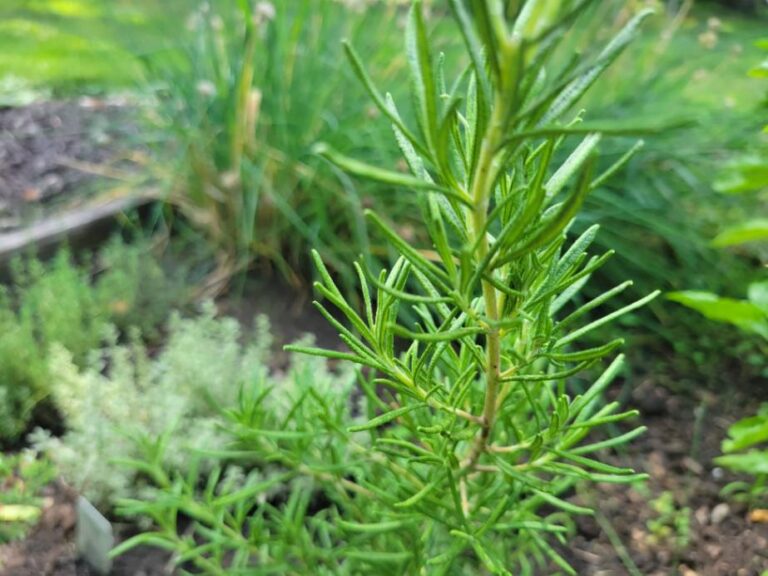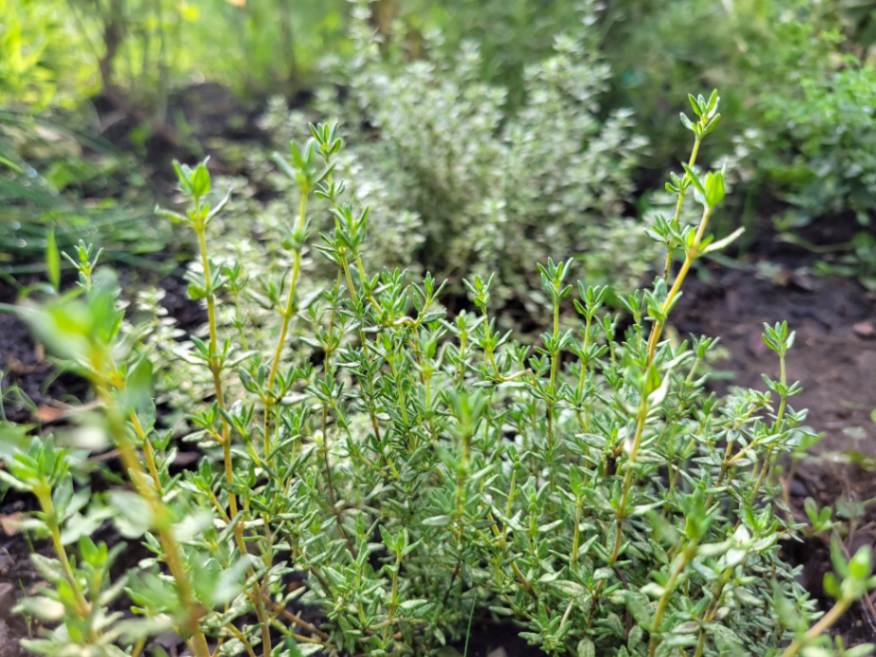This post may contain affiliate links which means I may receive a commission for purchases made through links. I only recommend products that I have personally used. As an Amazon Associate I earn from qualifying purchases. Learn more on my Private Policy page.
Rosemary and thyme not only complement each other in terms of flavor and culinary uses but also grow extremely well together in the garden.
Rosemary and thyme are excellent garden companions that thrive in similar growing conditions. They are drought-tolerant, prefer well-drained soil, and have shared watering needs. When planted together, they act as natural pest repellents, and their contrasting growth patterns prevent competition for space.
Let’s dig deeper into why thyme and rosemary are great garden companions and how to best care for their growing needs.
Table of Contents
Shared Growing Requirements of Thyme and Rosemary
Drought-Tolerant Herb Companions
Rosemary and thyme are both drought-tolerant herbs, making them ideal companions in the garden. These herbs have evolved to survive in arid conditions and withstand periods of low rainfall. This shared characteristic makes them well-suited to be planted together.

Well-Draining, Loamy to Sandy Soils
Rosemary and thyme prefer well-draining soils that are rich in organic matter. They thrive in loamy to sandy soils that allow excess water to drain away quickly, preventing waterlogged roots. Thyme and rosemary also have similar pH preferences, with a preference for slightly acidic to neutral soil conditions.
Lower Watering Requirements Once Established
Once these herbs have become established, both rosemary and thyme have fairly low watering requirements compared to other herbs, such as basil or cilantro. I’ve found that this shared trait not only simplifies my gardening routine but also conserves water resources. By planting herbs with similar water requirements together, you help to ensure you meet your plants’ watering needs without overwatering them.
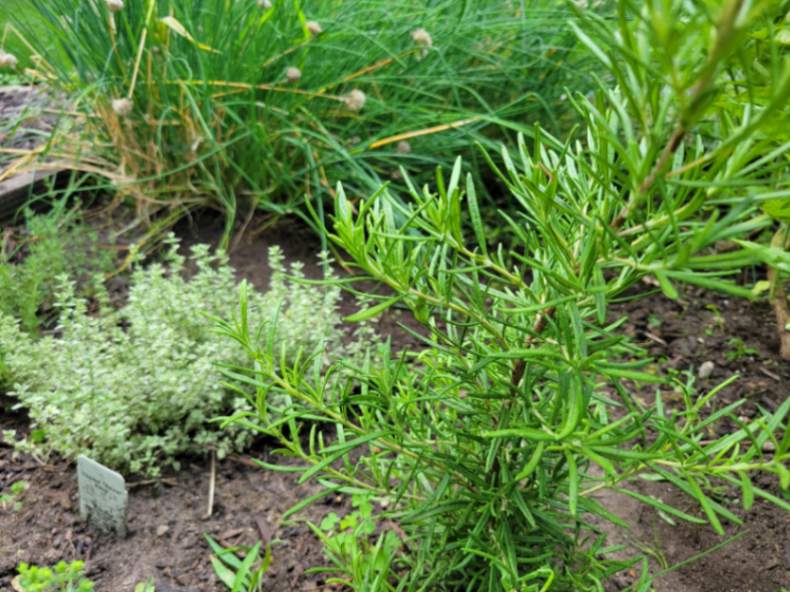
Sunlight Requirements: At Least Six Hours Daily
Rosemary and thyme both need ample sunlight. They require at least six hours of direct sunlight daily to thrive, so it’s best to plant them in an area that receives full sun exposure without obstructions like tall trees or buildings.
By considering their shared growing requirements when planting rosemary and thyme together, you help to create an environment that promotes healthy growth for both herbs.
Tips for Growing Rosemary and Thyme Together
Water Deeply but Allow the Soil to Dry Out Between Waterings
Rosemary and thyme are both drought-tolerant herbs, so they don’t require frequent watering. However, when you do water them, make sure to water them deeply. This means giving them a thorough soak until the water reaches their root zone.
Allow the soil to dry out between waterings. Overwatering can be detrimental to both rosemary and thyme as it can lead to root rot. Allowing the soil to dry out slightly between watering sessions helps prevent excessive moisture that can harm the roots. Generally speaking, watering rosemary and thyme every 10-14 days should suffice.
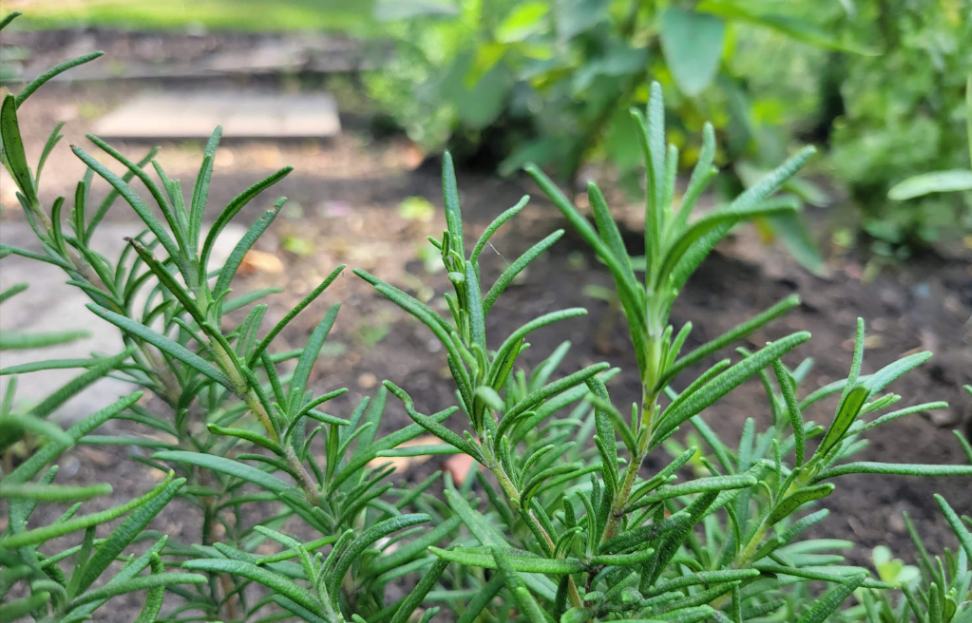
To prevent root rot, it’s also important to ensure that your planting containers or garden beds have proper drainage. You can achieve this by adding perlite or sand to the soil mix or creating raised beds with good drainage systems.
Monitor the moisture levels of your plants regularly. Stick your finger about an inch into the soil. If it feels dry at that depth, it’s time for another deep watering session. By being mindful of their watering needs and avoiding overwatering, you can maintain healthy rosemary and thyme plants.
Prune and Harvest Regularly for Healthy Rosemary and Thyme
Regular pruning and harvesting are essential for promoting healthy growth in rosemary and thyme plants. Pruning helps prevent legginess, encourages bushier growth, and improves airflow around the foliage, which reduces the risk of diseases.
When pruning rosemary, remove any dead or damaged branches and trim back any excessive growth. Thyme can also benefit from regular pruning to keep it compact and encourage new growth.
In addition to pruning, harvesting the leaves of rosemary and thyme promotes their overall health. Regularly snipping off sprigs for culinary use not only provides you with fresh herbs but also stimulates the plants to produce more foliage.

When harvesting, avoid removing more than one-third of the plant’s foliage at a time. This allows the plants to recover quickly and continue growing vigorously.
For optimal harvesting techniques for these herbs and for some tips on how to preserve them, check out my harvesting guides below:
What Should Not Be Planted with Rosemary and Thyme?
Avoid Planting Rosemary and Thyme Near Water-Loving Herbs
Rosemary and thyme prefer dry conditions and thrive in well-drained soil. Therefore, it is best to avoid planting them near water-loving herbs, such as:
These herbs have different moisture requirements that can’t be met simultaneously for both groups of plants. Meeting the watering needs of one group can lead to stunted growth or even the death of plants in the other.
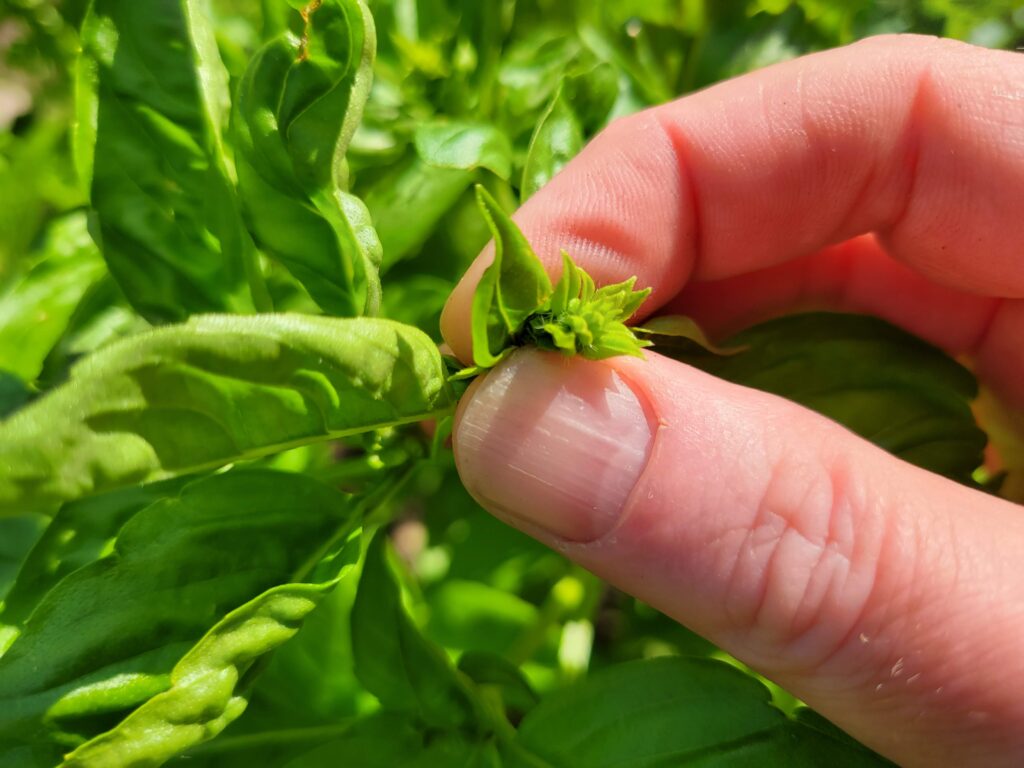
Cucumbers and Tomatoes are Poor Rosemary Garden Companions
While cucumbers and tomatoes are popular garden vegetables, they are not good companions for these herbs, particularly rosemary. These vegetables spread out and occupy a significant amount of space in the garden bed, depriving your herbs of essential sunlight.
Cucumbers and tomatoes require regular watering to maintain their moisture levels, which can harm the drought-tolerant nature of rosemary and thyme. The excess moisture in the soil can lead to root rot or other fungal diseases that affect these herbs’ health.
I should note that, despite their differing water needs, tomatoes can benefit from thyme being nearby, as thyme can act as a natural deterrent to tomato pests such as aphids and tomato hornworms.
For a deeper dive into what does and does not grow well with rosemary and thyme, check out my companion planting guides for these aromatic garden herbs below…
Rosemary Companion Planting
Optimize your garden with rosemary companion planting. Discover ideal plants to pair and those to avoid for a thriving garden. Read More…
Thyme Companion Planting
Discover the best and worst thyme companion plants for successful pairings. Learn what to grow (and what not to grow) with thyme. Read More…
Growing Rosemary and Thyme Together in Containers
Choose a Large Container with Good Drainage for Growing Rosemary and Thyme Together
When planting herbs like rosemary and thyme together, it’s important to select a large container that provides ample space for both plants to grow. A container with a minimum depth of 12 inches will allow the roots to develop properly. Ensure the chosen pot has good drainage to prevent waterlogging, as these herbs prefer well-draining soil.
Use a Well-Draining Potting Mix When Container Gardening with Rosemary and Thyme
To create an optimal growing environment for rosemary and thyme, use a well-draining potting mix specifically designed for container gardening. This type of soil blend allows excess water to drain away efficiently, preventing root rot and other moisture-related issues. Avoid using heavy garden soil or compost alone, as they tend to retain too much moisture.
I’ve found that mixing in a cactus planting mix really helps to improve the drainage when planting drought-tolerant herbs in containers. In my experience, a ratio of one part cactus mix to two parts potting mix works pretty well for herbs that prefer dry growing conditions.
Place the Container in a Sunny Location
Rosemary and thyme thrive in full sun conditions, so it’s important to place the container in a sunny spot. These herbs require at least six hours of direct sunlight daily to flourish. If you are growing them indoors, choose a south-facing window or use artificial grow lights to provide adequate light.

Regularly Monitor Moisture Levels and Water When the Top Inch of Soil Feels Dry
While rosemary and thyme prefer drier conditions, they do still require watering on a fairly regular basis. Check the moisture level by inserting your finger into the top inch of soil; if it feels dry, it’s time to water. Be careful not to overwater, as this can lead to root rot.
Rosemary and thyme share similar growing requirements, making them compatible companions in any patio or container garden. Both rosemary and thyme thrive in well-drained soil with full sun exposure and require minimal watering once established.
Frequently Asked Questions (FAQs)
Can I grow rosemary and thyme indoors?
Rosemary and thyme can be successfully grown indoors as long as they receive at least six hours of direct sunlight per day. Choose a sunny window or use artificial grow lights to provide the necessary light intensity for healthy growth.
How often should I water my rosemary and thyme plants?
Both rosemary and thyme prefer dry conditions, so it’s important not to overwater them. Water deeply but infrequently, allowing the soil to dry out between waterings. Aim to water once every 10-14 days or when the top inch of soil feels dry.
Can I use fresh rosemary and thyme interchangeably with dried herbs?
Fresh rosemary and thyme have a more intense flavor than their dried counterparts. However, you can substitute dried herbs for fresh ones by using approximately one-third of the amount called for in recipes.
Are there any pests or diseases that affect rosemary and thyme?
Rosemary and thyme are generally resistant to pests and diseases. However, they can occasionally be affected by spider mites, aphids, or powdery mildew. Regularly inspect your plants for any signs of infestation or disease and take appropriate measures if necessary.
Can I propagate rosemary and thyme from cuttings?
Both rosemary and thyme can be easily propagated from stem cuttings. Take a 4-6 inch cutting from a healthy plant, remove the lower leaves, and place it in a well-draining potting mix or water until roots develop, which usually takes about 4-6 weeks.
See my article on How to Grow Rosemary from Cuttings for additional tips on techniques.
How long do rosemary and thyme plants live?
Rosemary plants can live for several years with proper care, while thyme plants typically have a lifespan of around 5-7 years. Regular pruning and providing optimal growing conditions can help extend the longevity of these herbs.
Can I use rosemary and thyme together in cooking?
Rosemary and thyme complement each other beautifully in various culinary dishes. Their aromatic flavors blend harmoniously to enhance roasted meats, vegetables, soups, stews, marinades, sauces, and baked goods like bread or focaccia. Experiment with different combinations to discover your favorite flavor pairings.
Last Updated on 31 October 2023 by Bob Lee

